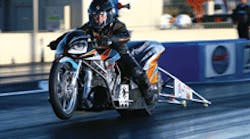Reverse Engineering Builds a Better Motorbike for the Drag Strip
Creaform, www.creaform3d.com Fisher Motorsports, www.fischermotorsports.com Rapidform, www.rapidform.com |
Motorsports racing shop Fisher Motorsports in Rowlet, Tex., used a portable scanner and point-processing-software to digitally capture the shape of an original Kawasaki crankcase and generate an editable 3D CAD model, which was then modified to yield a stronger case. Funny-bike racing has suffered from a weak link — the clutch. The racer must slip the clutch, riding a thin line between bogging the engine and wearing out the clutch. Either situation can cost a race, so shop owner Shawn Fisher designed and built a centrifugal clutch similar to those used in funny cars to maximize the power available from the motor while minimizing wheel slippage at each shift. The Handyscan 3D digitizer and Rapidform XOR software from Creaform Inc. in Quebec, Canada, provided the scanning and modeling technology.
As the name implies, a centrifugal clutch uses a circumferential array of weights that translate the centrifugal forces of the spinning mechanism into compressive forces on the clutch plates. The faster the clutch spins, the tighter it locks up. Should the engine begin to bog, the clutch slips.
Fisher’s first design burned-up within 1/16th of a mile. Physical analysis showed that the clutch failed when the friction materials wore away during the shift into second gear. But telemetry analysis revealed the clutch had launched the bike more quickly for the first 60 ft then ever before. Fisher decided to replace the Kevlar materials with carbon fiber as is used in funny-car clutches.
Unfortunately, Kawasaki motors work with what are called “wet clutches,” which operate in a bath of crankcase oil, and carbon-fiber plates can’t run in an oil bath. Using a dry clutch meant redesigning the crankcase to strengthen it, as well as separate the crankcase oil from the clutch chamber. Because Kawasaki would not release its proprietary design, Fisher had to generate a CAD model of the original crankcase and modify it to handle 800 hp (5× larger than stock).
“The Handyscan is easy to use,” says Fisher. “I just placed the small reflective targets on the Kawasaki crankcase, pointed the scanner, and laser-scanned the case. The point-processing software captured the component’s shape and its discreet features, and generated the feature relationships in a history tree, for an editable, parametric 3D CAD model that included the original engineer’s design intent. I modified the model, evaluated the strength of the new design in CAE software, and then fabricated the redesigned components. The latest iteration of the centrifugal clutch is undergoing tests, with every indication it will let the bike gain 0.2 sec, a huge amount for a 6-sec class.”
About the Author
Leslie Gordon
Leslie serves as Senior Editor - 5 years of service. M.S. Information Architecture and Knowledge Management, Kent State University. BA English, Cleveland State University.
Work Experience: Automation Operator, TRW Inc.; Associate Editor, American Machinist. Primary editor for CAD/CAM technology.
